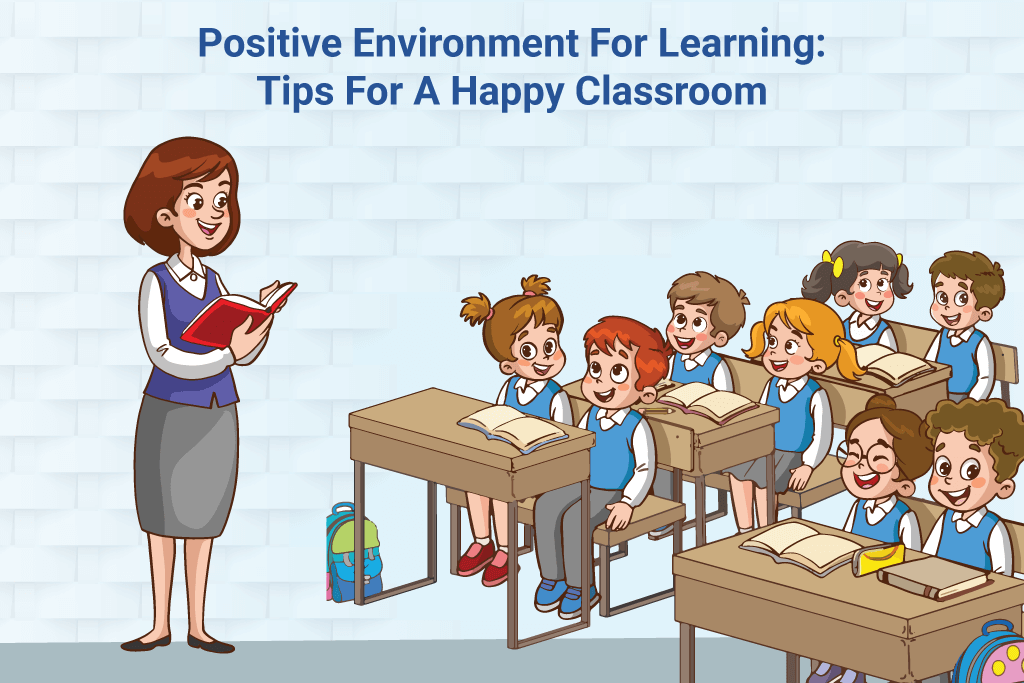Positive Environment For Learning: Tips For A Happy Classroom

A child’s journey towards intellectual and emotional growth begins in the classroom, where they spend a significant amount of their time. It is more than just a setting for education; it is a place where a child’s cognitive abilities are cultivated. However, for the child to truly flourish, they must be in a positive environment for learning that promotes positivity and provides opportunities for enriching learning experiences.
In this blog, we will look at some tips that you can use to create a happy and conducive learning environment for your students. But first, let us understand what a positive classroom environment looks like.
Ready to transform your classroom into a happy, thriving learning environment?
A] What Is An Effective School Environment?
A happy and effective classroom is one that can nurture the holistic development of a child. Such a classroom comprises physical, emotional, social, and academic elements that promote a supportive atmosphere. In an ideal learning environment, students feel more comfortable. There are well-maintained facilities and resources with the help of which a student can easily learn.
A child studying in a positive learning environment feels more valued and respected. Their instructors constantly support them and motivate the students to do their best. It is a place where a child feels a sense of belongingness.
A learning environment is also effective when there is good collaboration, empathy, and positive relationships between students. Children get meaningful learning experiences that fit their learning styles and abilities. They get more chances for critical thinking and creativity.
B] How To Create A Positive Learning Environment?
The below-mentioned are a few tips to help you create an ideal learning environment.
1. Create Positive Relationships With Learners And Parents
A strong relationship with students and their parents lays the foundation for a supportive learning environment. As an instructor, you must take the time to know each student individually. It is important that you show interest in their interests and strengths.
If parents come across any learning challenges, you must be able to provide solutions to them at the earliest. Also, it is important that you regularly communicate with parents. Keep them informed about what their child is doing in the classroom so that they can take part in the decision-making for their child. It will help you engage students in active learning.
2. Establish Strong Connections Between Students
Positive relationships only between students and teachers are not enough to create a conducive classroom environment. There should be a sense of community within the classroom. Students should be able to bond with each other.
Tutors can present children with opportunities to work on projects together or involve them in fun phonics activities. It is also a good idea to schedule group discussions once in a while so that students can communicate with each other.
3. Encourage Positive Behavior
There is a difference in the behavior of every student. It is important that a student learns kindness, respect, and perseverance. This behavioral conduct helps in creating a positive classroom environment in your classroom. Instructors can start by praising students for their good behavior so that they always have the motivation to behave well.
You can also implement a reward system or give away some incentives to students for upholding this behavior inside and outside the classroom environment. Learning good behavioral practices will not only make them kind towards their classmates but also make them a good human for life. It is also important that tutors provide guidance and support to children to help them learn from their mistakes and make positive choices.
4. Nourish A Positive Environment
A classroom should look and feel welcoming. You can decorate the classroom’s walls with inspiring educational content. The premises should be clean and well-maintained to leave an impact on the student.
You can also incorporate some natural elements in the class like plants or natural lighting to create a calm and an ideal classroom physical environment. When a classroom looks visually appealing, a child is always motivated to get up and look forward to new learning experiences.
5. Maintain A Child’s Comfort
For a classroom to be a happy place for a child, it is essential that they feel comfortable. It is also important that students have comfortable seating options, access to water, and healthy snacks. They should also get opportunities for movement and relaxation throughout the day.
6. Promote Social And Emotional Learning
Emotional and social learning is a very important part of a child’s education. Inculcating social and emotional skills in students helps them learn about empathy, self-awareness, and conflict resolution. You can integrate activities in their learning experience where they can practice these skills in real-life situations.
If you foster a culture of acceptance and understanding within your classroom, students can feel safe while expressing their emotions. They can seek help and support from you whenever needed. It helps in building positive relationships with their classmates and a good learning environment in the classroom.
7. Keep Children Motivated
You can keep children always engaged in the classroom by using interactive teaching methods. For example, you can use hands-on experiments, group discussions, and educational games to avoid the classroom sessions from being boring. Incorporating active learning in kindergarten will help in bringing out the creative side of the students.
For example, you can use several phonics learning methods to make learning fun. Also, it is important to remember that students have different learning styles and pace. So, your teaching methods should be able to accommodate different learning styles.
8. Spread Love
Finally, an inclusive classroom environment is full of love. As an educator, you must take the initiative to show kindness, compassion, and appreciation towards students. You should celebrate students’ achievements, big and small, and acknowledge their efforts. Children can feel more motivated to learn in a classroom that is full of
positivity.
Ready to transform your classroom into a happy, thriving learning environment?
Conclusion
Cultivating a positive learning environment is not just about helping students grow academically. A child nurtures and grows in a place that provides him with comfort and makes him feel motivated. Creating an ideal classroom environment will not only ensure good grades but also make them good human beings.
A classroom is happy when all the students can resonate with each other and treat one another with kindness and respect. These qualities are sure to stay with the students in the long run. Our phonics classes in Mumbai understand the importance of what a positive environment holds in efficient learning and personality building, and thus strive to implement tips for a happy classroom effectively, contact us and explore today.

Hema Dave
Stemming from the aspiration to nurture and inspire young minds, Hema started her professional journey into education 20+ years ago. She founded 'Phonic Smart' as a trained educationist, an institute committed to equipping children with phonics skills and helping parents and teachers implement them effectively. Her diverse skill sets, encompassing teaching, teacher training, and coaching allow her to contribute valuable insights to the education industry.

